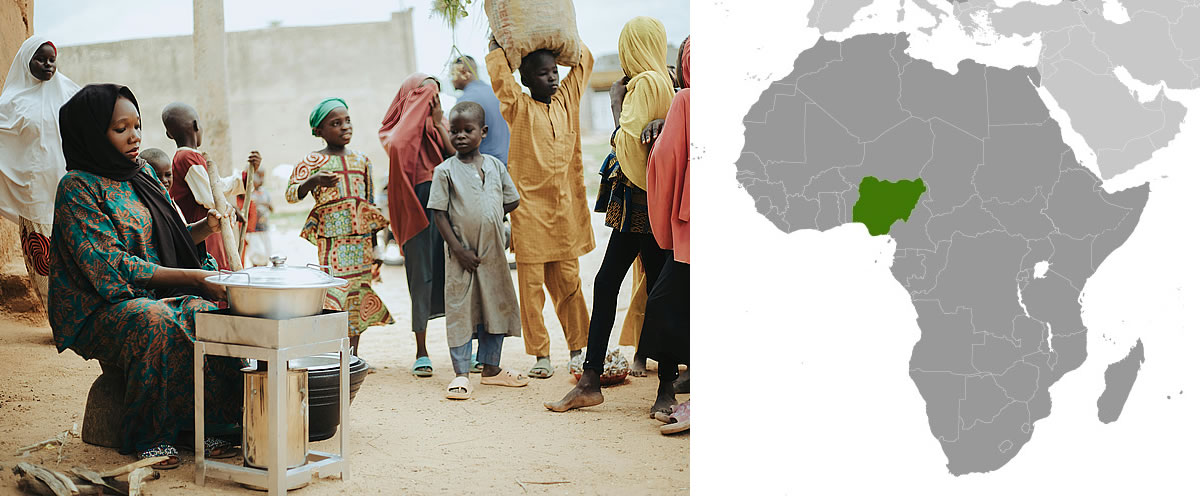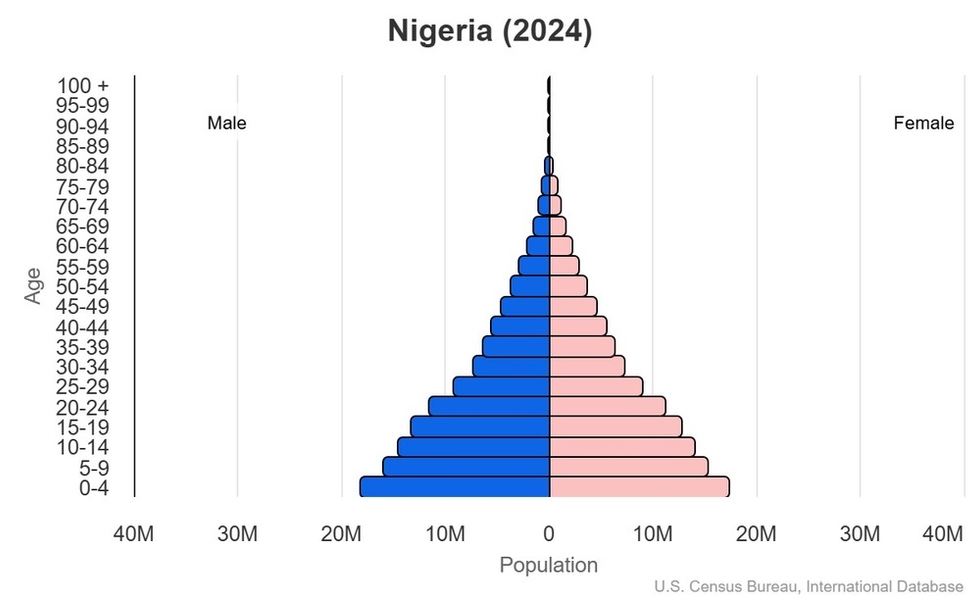
Data & Statistics Nigeria
NG
Nigeria is a country of contrasts—rich in culture, population, and resources, yet facing persistent social and economic challenges. Reliable data helps us understand these realities and track the nation’s progress over time.
Nigeria Population 2025 - UNPF
Total Population (2025): 237,500,000
- Total population in millions, 2025: 237.5
- Population annual doubling time, years, 2025: 34
- Population aged 0-14, per cent, 2025: 41
- Population aged 10-19, per cent, 2025: 24
- Population aged 10-24, per cent, 2025: 34
- Population aged 15-64, per cent, 2025: 56
- Population aged 65 and older, per cent, 2025: 3
- Total fertility rate, per woman, 2025: 4.3
- Life expectancy at birth, years, 2025, male: 54
- Life expectancy at birth, years, 2025, female: 55

Age structure
- 0-14 years: 40.4% (male 48,856,606/female 46,770,810)
- 15-64 years: 56.2% (male 66,897,900/female 66,187,584)
- 65 years and over: 3.4% (2024 est.) (male 3,759,943/female 4,274,287)
Nigeria Data & Statistics Women and Girls
Women’s Day Nigeria 2025
Each year, on Women’s Day Nigeria, October 1, we dedicate special attention to the situation of women and girls. From education and literacy rates to maternal health, gender-based violence, child marriage, and female genital mutilation, the statistics reveal both the progress achieved and the barriers that remain.
By reviewing these figures annually, we highlight where change is happening, where challenges persist, and how Nigeria compares regionally and globally. The goal is to create a transparent picture that can inspire action, accountability, and solutions—so that every woman and girl in Nigeria can live with dignity, opportunity, and equal rights.
| Issue | Latest Data & Year | What It Shows / Significance |
|---|---|---|
| Poverty (Women & Girls) | • 54% of Nigerians projected to live in poverty in 2024. • 75.5% of rural Nigerians are poor (2025), vs 41.3% in urban areas. • At the lower-middle income poverty line (~US $3.65/day), ~63.9% of females are classified as poor. • Female-headed households, women in informal work etc have heavier burdens of poverty. A 2024 study using 2018/2019 data (Harmonized Nigeria Living Standards Survey) finds that over 75% of rural women in Nigeria are multidimensionally poor. Rural women have an average “intensity” of deprivation of ~ 47% (i.e. they suffer almost half of the weighted deprivations measured). Living standards items, time to health services, unemployment, large household size, low education, lack of access to credit are major contributors. | • A very large share of women—especially in rural areas—live with multiple simultaneous deprivations, not just low income. These include poor housing, limited services, weak healthcare access, and education deficits. • The depth (how many deprivations each woman faces) is very high, meaning policies focused only on one dimension (say income) will leave many behind. • Because rural women make up a large portion of the poor population, reducing poverty among them would significantly lower overall national poverty. • Key risk factors (low education, no credit access, large households) suggest where interventions (education, social protection, services) can be most effective. |
| Literacy / Education | • In a 2024 survey by StatiSense, Imo state has the highest literacy rate among women aged 15-24 at 83.5%. Anambra next at 78.4%, Ebonyi at 74.3%. • Some states (especially in the south / middle belt) appear to be doing better in terms of female youth literacy; disparities remain, especially with rural vs urban areas. | While youth literacy is high in some states (especially in the South), adult basic literacy remains low and is declining, showing gaps especially for older women or out-of-school populations. |
| Family Planning / Reproductive Health | • Unmet need for family planning: 21% for married women, 3% for unmarried women (2023-2024) • Modern contraceptive use: 15% for married women; 38% for unmarried women (2023-24 DHS) • South West region has highest modern contraceptive use (≈ 43.9%) vs North West (~11%) and North East (~13.1%) | Progress toward family planning targets is slow; big regional disparities; cost, culture, and access remain barriers. |
| Maternal Mortality & Health | • In humanitarian and conflict-affected areas (e.g. Borno, Adamawa, Yobe), many women of reproductive age are cut off from SRH services; UNFPA reports on pregnancy, family planning, GBV support in IDP / crisis zones (2024-25) • Federal Government reaffirmed goal of 27% modern contraceptive prevalence rate by 2030; fertility has declined from ~6 children per woman (1990) to ~4.8 today (2024) | Maternal health is especially threatened in conflict zones and by funding gaps. Fertility decline is real but still high; reaching family planning/ maternal health goals requires major scaling up. |
| Gender-Based / Sexual Violence (GBV / SGBV) | • 27,698 SGBV cases recorded from 2020-October 2023 via GBV National Dashboard • Over 30,000 GBV cases reported officially between 2020-2024 to Ministry of Women Affairs • Federal Capital Territory (FCT) alone had ~3,072 GBV cases early in 2024 | GBV remains a widespread issue, with increasing reporting in many places; still, underreporting and poor enforcement hinder full understanding. |
| Female Genital Mutilation (FGM) | • ~ 20 million women & girls have undergone FGM in Nigeria (2025) • National prevalence among women aged 15-49 ~ 20% (recent reports) • Risk: ~ 4.3 million girls are at risk in a given year (2025 estimate) | FGM remains widespread despite some declines; many cases happen very early (often before age 1); progress insufficient to meet the goal of elimination by 2030. |
Gender-Based Violence
Approximately 1 in 3 Nigerian women have experienced physical violence by age 15, with one in three women experiencing physical, sexual or intimate-partner violence throughout their lifetime. Violence against women in Nigeria manifests in many forms, including domestic, verbal, and physical abuse, rape and sexual assault, early and forced marriages, incest, female genital cutting, acid baths and outright killing. The situation remains critical, with 17 femicide incidents resulting in 19 deaths reported in the first months of 2025 alone.
Female genital mutilation continues to be prevalent in many parts of Nigeria due to deeply entrenched cultural and religious beliefs, though women-led initiatives are emerging in Northern Nigeria to combat gender-based violence and foster peace and social cohesion.
HIV/AIDS
Current data indicates a national HIV prevalence in Nigeria of 1.3% among adults aged 15-49 years, with an estimated 1.9 million people living with HIV. This represents a significant improvement from previous estimates of 2.8%. HIV prevalence has decreased from 4.1% in 2010 to 1.4% in 2019, with new HIV infections dropping from 120,000 in 2010 to 74,000 in 2021, and HIV-related deaths decreasing from 82,000 in 2010 to 51,000 in 2021. While women still constitute a majority of people living with HIV globally, the specific gender breakdown for Nigeria in 2025 was not available in recent sources.
Women’s Political Representation
Nigeria continues to have one of the lowest rates of women’s political representation globally. As of 2025, there are only 4 women senators out of 109 and 16 women in the 360-member House of Representatives, representing 2.8% of MPs in the upper chamber and 3.9% of MPs in the lower chamber following the 2023 elections. Since independence in 1960, Nigeria has never had a woman serve as President or Vice President.
Nigerian women, who make up the majority of the electorate, are pushing for legislation that would reserve at least 35% of seats in parliament for women, though such bills have been repeatedly blocked by lawmakers.
- Al Jazeera (March 2025)
- Inter-Parliamentary Union data on Nigeria
UN Women Nigeria
UN Women Nigeria:
africa.unwomen.org/en/where-we-are/west-and-central-africa/nigeria
Women Peace and Security (WPS) Nigeria:
africa.unwomen.org/en/where-we-are/west-and-central-africa/nigeria/women-peace-and-security
Women Count Data Hub: Nigeria
Gender data gaps and country performance
data.unwomen.org/country/nigeria
National Bureau of Statistics
The National Bureau of Statistics (NBS) came into being with the merger of the Federal Office of Statistics (FOS) and the National Data Bank (NDB). The creation was part of the implementation of the Statistical Master Plan (SMP), a programme document of the Federal Government of Nigeria (FGN).
The merger was to give the agency a national outlook as the apex statistical agency for all the three tiers of Government.
NBS is expected to coordinate Statistical Operations of the National Statistical System in the production of Official Statistics in all the Federal Ministries, Departments and Agencies (MDAs), State Statistical Agencies (SSAs) and Local Government Councils (LGCs)
Nigeria operates Federal System of government with 36 States and Federal Capital Territory and 774 Local Government Areas (LGAs). At the federal level, each Ministry, Department and Agency has Director of Statistics. Each state has Director of Statistics and Head of statistics Unit at Local Government Areas. All these including Statistical Institutes constitute the Nigeria National Statistical System (NSS).
The Internal Organisation of the bureau is built on Statistics Act of 2007 which is the Legal Instrument established by the Acts of Parliament.
nigerianstat.gov.ng

